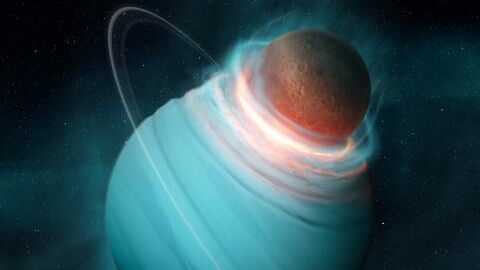66.5 light-years. That's the "short" distance that separates us from a new exoplanet dubbed GJ 1252 b that was discovered by researchers at the Massachusetts Institute of Technology (MIT) Kavli Institute for Astrophysics and Space Research (United States). A revelation that means our “cosmic neighbourhood” is, indeed, a space that is fully capable of hosting populated planets.
Discover our latest podcast
The newly observed star, which orbits around a red dwarf star, is slightly larger than Earth. And it should help scientists bridge their knowledge gaps when it comes to the small rocky planets found in our galaxy, the Milky Way.
In search of small exoplanets
Since the first discovery of an exoplanet in 1995, our ability to detect them has grown exponentially: more than 4,100 planets outside the Solar System have been confirmed. Only about fifteen are Earth-sized and are located in what is called "the habitable zone," in other words, a part of space where conditions are favourable to the appearance of life - at least, to life as we know it on our blue planet.
Exoplanets, however, remain “dark little things” that are very difficult to see from a distance. Most of those that are confirmed are ice or gas giants, which are more or less the size of Neptune. Research missions like Kepler and its current successor TESS (Transiting Exoplanet Survey Satellite), have detected many smaller exoplanets. These stars are closer to the mass of Earth or Venus, and therefore more likely to be rocky - one of the prerequisites for life.
Valuable data
Despite technological progress, these rocky planets remain difficult to characterize because, a lot of the time, researchers cannot find a star bright enough for them to do research on. That's why the detection of this new exoplanet is such important news.
"Based on TESS data and additional monitoring data, we are able to reject all false positive scenarios, showing that this is a real planet," the researchers wrote in their study, which was submitted to the American Astronomical Society and has been available on arXiv since December 11. In it, they describe their discovery.
GJ 1252 b is approximately 1.2 times the size and twice the mass of the Earth. It revolves around a red dwarf, called GJ 1252, in just 12.4 hours. So, like the Moon, this planet only shows one side to its star. The side it shows is believed to be very hot and its dark side, very cold. This rules out habitability. But its tight orbit makes it interesting for another reason.
Just 66.5 light-years away, this system is close enough and the star bright enough for it to be observed down to the smallest details. If GJ 1252 b has an atmosphere, it will be backlit by the light of GJ 1252, allowing astronomers to see what it's made up of through spectroscopic observations.
The importance of exoplanets
The more rocky planets we find near us, the more data we can compile to understand what they look like. Those known at the moment are sterile lands, like Mercury, Venus or Mars... Perhaps Earth isn't so unique after all and is actually a common type of planet in the Milky Way. And of course, this research is closely related to the search for extraterrestrial life.
So, we'll have to wait. But there's still hope! Last September, astronomers detected the presence of water vapour in the atmosphere of an exoplanet, making it potentially habitable.















